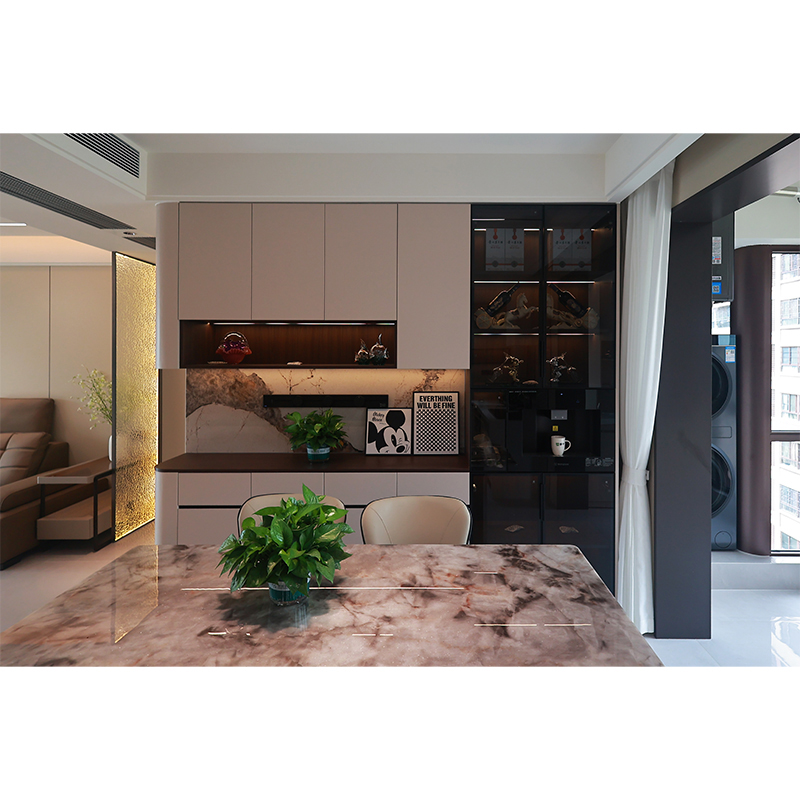Does the installation precision of a custom TV cabinet significantly affect its overall aesthetics?
Release Time : 2025-11-05
The installation precision of a custom TV cabinet is one of the core elements determining its overall aesthetics. From the fit between the cabinet and the wall to the gaps between components, from horizontal and vertical alignment to the finishing touches, every installation detail directly affects the visual presentation. Installation precision not only reflects the brand's craftsmanship but also directly impacts the user's perception of home quality. Especially in modern home environments that emphasize overall design and spatial harmony, even minor installation deviations can ruin the refinement and sophistication of a custom TV cabinet.
The fit between the cabinet and the wall is the primary indicator of installation precision. Custom TV cabinets are typically custom-made to fit the wall's dimensions and shape. If precise measurements or adjustments are not made during installation, problems such as excessive gaps, unevenness, or misalignment can easily occur. For example, if the wall is slightly tilted, without correction using shims or adjusting the cabinet legs, the cabinet may appear to be "leaning forward" or "leaning backward," disrupting the sense of spatial balance. Improperly handled gaps can also expose rough installation and reduce overall aesthetics. A professional installation team will use laser levels, straightedges, and other tools for multi-dimensional calibration to ensure a seamless fit between the cabinet and the wall, creating a unified visual effect.
Controlling the gaps between components directly affects the sophistication of the custom TV cabinet. Large or uneven gaps at the joints of cabinet doors, drawers, and shelves will appear loose and cheap, especially noticeable on high-gloss panels or light-colored cabinets. For example, when the gap in a cabinet door exceeds 3mm, light refraction will magnify the imperfection, creating a visually distracting "black line." Uneven gaps between drawers and the cabinet can lead to difficult sliding, affecting the user experience. High-end custom brands use precision mortise and tenon structures or concealed connectors to reduce exposed gaps, and repeatedly adjust to ensure every joint is perfectly fitted, showcasing meticulous craftsmanship.
Level and vertical alignment is a fundamental requirement for installation precision. Custom TV cabinets must be perfectly level and perpendicular to the floor and ceiling; otherwise, a chain of problems will occur: tilted cabinets may prevent doors from closing completely, drawers from sliding smoothly, and even affect the stability of the TV hanging; while crooked shelves will ruin the neatness of the internal storage and reduce practicality. During installation, workers will use a level to check the cabinet and shelves at multiple points, and ensure absolute levelness by adjusting the height of the cabinet legs or reinforcing the brackets, avoiding installation deviations caused by uneven floors or wall errors.
Detailed finishing is the "finishing touch" of installation precision. Improperly handled details such as edge trims, baseboards, and LED strip channels can easily become visual flaws. For example, edge trims that don't match the cabinet's color or material will look jarring; excessive gaps between the baseboard and the floor will easily accumulate dust and be difficult to clean; and crooked LED strip channels will disrupt the uniformity of the lighting atmosphere. A professional installation team will plan the finishing scheme in advance, selecting finishing strips of the same color and material as the cabinet. They will ensure a tight fit of the baseboards through pre-embedded clips or adhesive bonding, and simultaneously calibrate the angle of the LED strip grooves to create soft, non-glaring light, enhancing the overall sophistication.
Installation precision is closely related to the design style of the custom TV cabinet. Modern minimalist styles emphasize clean lines and simple shapes, demanding higher installation precision—any slight deviation can compromise the purity of "minimalism." While European or Chinese styles allow for certain decorative details, misaligned carved components or unbalanced symmetry can still appear crudely made. Therefore, the installation team needs a deep understanding of the design intent and to develop differentiated installation standards for different styles. For example, flexible connectors will be used for curved cabinets, and templates will be used for symmetrical patterns to ensure the complete presentation of the design language.
Installation precision also affects the durability and safety of the custom TV cabinet. Tilting the cabinet can lead to uneven stress over time, causing deformation or cracking; loose parts may detach during use, creating safety hazards; and disorganized cable management can cause connections to loosen due to pulling, affecting the use of appliances. Professional installation improves stability by reinforcing brackets, using anti-loosening screws, and providing cable redundancy. It also tests key functions such as cabinet door opening and closing, drawer sliding, and TV mounting to ensure installation precision not only serves aesthetics but also guarantees safety.
The installation precision of a custom TV cabinet is controlled across multiple dimensions, including cabinet fit, component splicing, horizontal and vertical alignment, detailed finishing, style matching, durability, and safety, ultimately resulting in a significant improvement in overall aesthetics. From tool calibration to craftsmanship details, from functional testing to style restoration, every step of the installation process requires meticulous attention to detail. Choosing a brand with a professional installation team is key to ensuring that the custom TV cabinet perfectly transforms from a design into a work of art, and is also an important guarantee for users to enjoy a high-quality home life.







